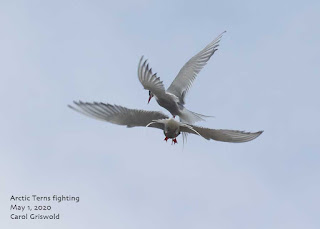Seward, Alaska
Sunrise 5:18 am, sunset 10:32 pm for a total daylength of 17 hours and 13 minutes. Tomorrow will be 4 minutes and 39 seconds longer.
Mostly sunny today with a high of 67, south wind 18 mph. Partly cloudy for the weekend with temps in the high 50s, rain on the way to maintain the green eruption. Almost all the dead-looking plants burst into leaf; alder catkins dangle in the breeze, miniature elderberry and Mt Ash flowers unfold. The darn dandelions are already in bloom.
A surge of migrating RUFOUS HUMMINGBIRDS hit feeders all over the Seward area last weekend with many people reporting multiple hummers. On Sunday May 10, Todd Eskelin banded hummingbirds at Ava’s Place. She thought she had at 10, maybe more, fighting over the four feeders, chasing, and acting very territorial. Much to everyone’s surprise, Todd banded 4 males and 16 females for a total of 20!
Todd returned this morning and banded 3 males and 9 females in Old Mill Subdivision. Then he returned to Ava’s and banded 3 more males and 12 females. Around 10 am, he caught a recently banded female that was not banded in Alaska. The report has apparently not yet been filed, so we will have to wait to find out where. Pretty exciting refind! All this work nudges our understanding of Rufous Hummingbird migration patterns.
Todd made two very functional cylindrical traps out of 1/4” wire mesh with a slide-down door. Each door is controlled by a line on a fishing reel, monitored at the processing table. When a hummer flew into the trap to feed on the enclosed hummingbird feeder, Todd quickly gave the line some slack and it slid shut.
While the hummer buzzed around inside the trap like a mad bee, he gently reached in, trapped it in his hand, and then popped it into a cloth bag.
Amazingly, the hummer became almost completely docile, as if in abject resignation. Caught by aliens! Play dead!
After checking for a previous band, the first task was to band the impossibly tiny, toothpick-thin leg with his special tools and professional expertise. Next, overall assessment, wing and bill measurements, weigh-in, and finally a dab of water-soluable blue paint on the top of the head. This marker readily identifies a bird that has already been banded, like “Pete” and “RePete”, a male that apparently didn’t mind getting trapped.
Other males seemed to be very wary, recognizing the trap as something different from normal. Todd related how one male scrutinized the trap with suspicion, then followed the line directly back to Todd and hovered in front of his face, bristling with accusations. Pretty smart hummer!
After all the processing, the hummer is ready for release. I felt so fortunate when Todd placed the little jewels in my outstretched palm. Most lay quietly, adjusting to the newness of it all, wondering if they were really free. I could feel the heart beating so fast it was truly a hum. Then without warning, they shot off. Many headed straight back to the uncaged feeder, hungry and making up for lost time.
Prince William Sound, where Kate McLaughlin bands hummers in Cordova, is on the migration pathway leading to Seward. Another hummer congregating hot spot is at the Alaska Wildlife Conservation Center by Portage. From observations, it seems the hummers are breeding while migrating to their final destinations here and in coastal rain forests farther west.
So much to learn about these incredible marvels of Nature!!
Thanks to Todd, Kate, and hummingbird banders across the nation and in Alaska who help provide invaluable data to help us understand them better.
Todd requests that if anyone happens to spot a Rufous Hummingbird with a blue paint dot on its head, not at Ava's, to please send him an email at
todd_eskelin@fws.gov. That information may give a sense of distribution from the two banding sites. The blue dot is only visible up close or with binocs, and will not be easily noticed.
Todd also did a Facebook live event recorded on the Kenai National Wildlife Refuge Facebook page on Hummingbird Banding. There are a few glitches that will be fixed when the staff is able to get back to work and access their normal suite of tools.
https://www.facebook.com/watch/live/?v=218860046022226&ref=watch_permalink
Happy Birding!
Carol Griswold
Seward Sporadic Bird Report Reporter
























































